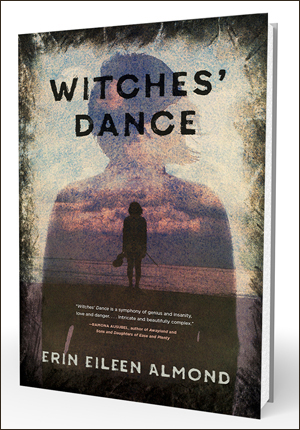Even though this debut novel is a literary fantasy rather than #coastalfiction, I had to review it—if only for the luxury of thinking more deeply about it. (Also I’m guessing this one will be easy to miss, partly due to its genre-busting and partly because that apostrophe in the title doesn’t search well, so I want to do my small part in giving it some much-deserved publicity.)

The title comes from the name of the fifth violin concerto by Niccolò Paganini, a virtuoso and composer from the early 1800s who is considered one of the developers of modern violin technique. In the book’s “prelude,” author Erin Eileen Almond draws us right into her world—while breaking several novel-writing rules. She begins by addressing the reader directly (“Paganini,” the first line reads. “What do you think when you hear that name?”) In the space of one paragraph, she crams in the historical highlights of Paganini’s biography, while simultaneously entrancing the reader by identifying what we “twenty-first century readers” might or might not already know. And then, so deftly I didn’t even notice at first, she suggests that we “become” her main character—quite a unique form of introduction:
“Say, instead, that you are Phillip Manns, a twenty-three year old savant about to solo with the Boston Symphony Orchestra…. In that case, the year must be 1984. And although your given name is Phillip Manns, you must believe, despite how crazy it sounds, that you are Niccolò Paganini, or at least his reincarnation.”
Fantastical narrators
Only a few paragraphs in, and we already “know” more about the main character than simple words could ever convey—including the “fact” that he is not completely trustworthy. A few pages later, she expands on this fantastical aspect; “In this story, the dead do not remain dead, for if one may be reincarnated, why not another?” Mad fantasy, perhaps—but also the building-blocks of a page-turning story.
One eye-catching member of Phillip’s audience at this 1984 performance is Hilda Greer, the seven year old girl who (we somehow already know) will become the other main character, when the first chapter opens in 1992. Now a teenager, Hilda has never forgotten Manns’ statement that night that “I am Paganini”—and even before she becomes his best violin student, she believes him. The “dance” that these two embark on starts at the Cambridge Conservatory in Massachusetts, diverts to a few dive bars (where Hilda plays violin in a rock band) and an Italian piazza, and eventually lands us on another concert stage at the 1993 Paganini Competition. That such a music event has been going strong since 1954 is just one of the many things I learned along the way.
Serious themes
This story tackles many dark topics: parental child abuse, alcoholism, mental illness, delusion. But it doesn’t preach or judge; instead, these negatives are seen as the unfortunate flip side of creativity and passion. Hilda’s mother Claire drinks too much and chases men, trying to drown the sorrows of a pregnancy-abandoned career as a ballerina, but she’s also quite self-aware and obviously trying her imperfect damnedest to do what’s best for her daughter and that amazing talent. Although early on I dreaded her mistakes, by the end of the book she’d become one of my favorite characters.
Lyrical language
My favorite paragraph had nothing to do with music, but it shows the reader a great deal about Claire and her regrets:
“…none of them had realized what they were getting into by marrying so young. The wrong kind of marriage, Claire knew now, was an ending. Your life stopped, and you entered a kind of stasis where all you could be was what you already were. The best kind of marriage—she imagined, she fantasized before every first date—would be a beginning, a gateway to a new life where you continued to grow, where you never stopped becoming.”
Music-infused
Woven through every paragraph is the violin music of Paganini and Vivaldi and Beethoven, as we follow Hilda’s inevitable progress toward her coming-of-age as both a violinist and a woman. Though I wasn’t specifically familiar with Witches’ Dance, listening to it as I write this review it feels somehow both familiar and completely fresh; both classical and modern. It is the perfect signature piece for an unstable savant who thinks he’s actually its composer, and also the perfect accompaniment for a dark book with a surprisingly happy (yet satisfying) ending.
Author Erin Almond deftly weaves fiction with fact to create this story. My only small quibbles are with a few point-of-view shifts later in the book that aren’t as clear as they might be, and a climactic scene that isn’t analyzed afterward quite as much as I thought it should be considering the changes it brought. Neither interfered with my deeming this book one of the best I’ve read in a long time—even though it is definitely NOT #coastalfiction!
Recommended to
Obviously this novel will resonate most deeply with musicians, but I recommend it to any passionate creative (as long as they can stomach literary fantasy). Just make sure to tell your local bookseller where the apostrophe should go in the title. Congratulations to Erin Almond for a fantastically deft debut, and I can’t wait to read what she produces next.